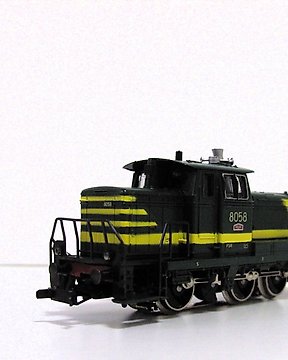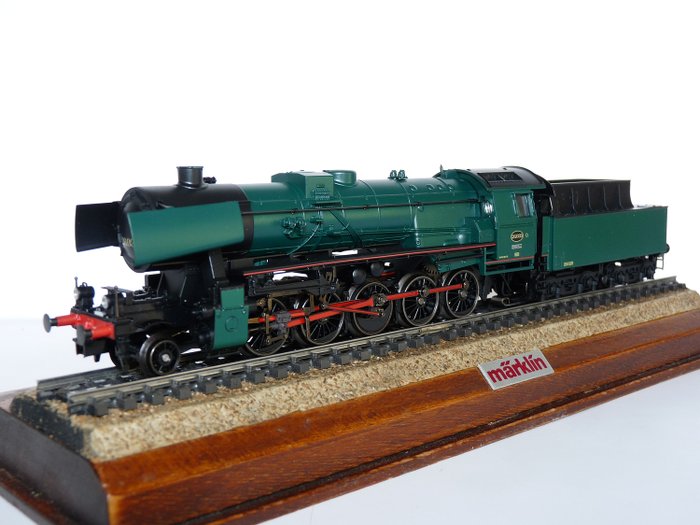
Märklin H0轨 - 3149.3 - 柴油液压机车 (1) - 80系列 - NMBS
编号 30587237

编号 30587237

Freight train locomotive series 26 of the Belgian State Railways (NMBS/SNCB) Former German series 52 with bogie tender and open cabin
With original packaging and booklet.
Running number:
Loc 26.033/Tender 26.025
2 running numbers are standard for this locomotive
The locomotive comes with a digital decoder and controlled high-efficiency propulsion.
Engine in the boiler of the locomotive.
Powered on 5 axles with 4 traction tyres.
Articulated undercarriage which enables a good run through curves.
Front lighting works in conventional operation and can be controlled digitally.
Smoke generator 7226 can be installed later.
Smoke generator contact and acceleration and deceleration digitally controlled with Control Unit 6021.
Length between the buffers is 26.3 cm.
The locomotive has hardly been on track, see (toothed) wheels and pickup shoe.
Front coupling and railings still to be mounted.
All functions have been tested.
In mint condition.
Master carton has some spots with discolouration.
Please see the photos of this very beautiful locomotive.
The presentation rail is not a part of this offer.
The Series BR 52 is a steam locomotive designed as War Locomotive by the Deutsche Reichsbahn in 1942-1943 the logistical requirements of the Wehrmacht during the Second World War. This series must not be confused with the DB Series 050, which were renumbered in 1968 as the Series 052 with the introduction of the new computer numbering. In Total, 7792 units of the construction Series 52 were built.
Development and Deployment:
The locomotives were designed with the Series BR 50 of the DRB as the example. They were designed to be able to haul heavy freight trains of up to 1,200 tons on various routes within Germany and the occupied territories, and also on secondary routes with badly constructed tracks at 65 km/h. In order to meet the demands of the Wehrmacht as quickly as possible, the design was simplified and cost savings were implemented in comparison to the 50 series. Copper and brass components were sparingly used and steel was used instead. This process began with the construction of the Series BR 50, which was called the transitional War Locomotive or the BR 50 ÜK.
Because the locomotive was constructed as simply as possible, a large number thereof could be manufactured in a short period of time. The first locomotives of this series were built in 1942. They were three tons lighter than the series 50, so the axle weight of 15 tons was hardly reduced. The frame consisted of rolled steel sheets. The boilers were made entirely of steel, in contrast to the series 50 which had copper fire grates. Later the boilers were also completely welded instead of being riveted. The connecting rods were two forged cross-heads with a welded I beam in-between these.
The bearings were replaced by white-metal strips in steel holders which replaced the previously used copper. The bearings of the axles were also replaced by steel. The smoke-deflectors fell away, and the whistle was made of steel. The safety valves on the cylinders also fell away,and were replaced by a this steel plate that gave way with excessive pressure in the cylinder. The Series BR 52 had 1 large sand box as opposed to the Series BR 50 which had 2. Preheating of the water is no longer done with a pre-heater, but by means of 2 tubes assembled inside each-other. The cold tender water first runs through the inner tube, and the steam flows through the outer tube, and thus brings the cold water to a higher temperature which is then pumped into the boiler.
The engineer’s cab was completely enclosed and attached to the tender with a sheath, so as to fend off the cold. The engineer’s cab was also equipped with underfloor heating and 2 seats with cushions. The central lubrication system was equipped with a steam pipe to keep the oil warm and so that the pump could also function well under cold conditions. The tender also had steam pipes running through it to keep the water liquid. The boiler and the water tanks of the tender were insulated with glass-fibre wool. All pipes and pumps were also insulated. The oil pipes ran between the boiler and the outer lining in order to keep them warm.
Once the available tenders of the Series BR 50 (Type 2'2'T26) were fully utilised, they then used the Steifrahmentender (type K4T30) and still later also used the Wannen tenders. In total, they used 89 kg copper and 19 kg zinc less than in the construction of the original Series BR 50. There were also 1000 fewer parts on the Series BR 52 when compared to the original 50 series.
The Series 52K locomotives of the DRG with a condenser tender with the company numbers 52 1850 – 2027, were converted for the Russian wide gauge and were fitted with a condenser tender in order to be used for long distances on the Russian tracks. With this condenser tender, the locomotives could travel a distance of 1200 km without taking on additional water.
With the condenser technology, the steam from the cylinders is not blown into the outside air, but this steam is passed through an oil separator within the condenser tender. In the condenser tender a turbine propels three fans, which cools the steam causing it to condense. This condensed water could then be re-used.
In the Series BR 52K, 2 types of condenser tenders were used, either a 4-axled or a 5-axled tender. The locomotives with a 5-axled tender were given the company numbers 52 1850 to 52 1986. The locomotives with a 4-axled tender were given the company numbers 52 1987 to 52 2027.
The locomotives from the Series BR 52 were typically used to haul medium-tonnage freight trains. If necessary, they also could also haul passenger trains due to their maximum speed of 80 km/h. In double traction format the heaviest freight trains could also be hauled. They were deployed by the East German railways until the end of the steam era in the 1990s.